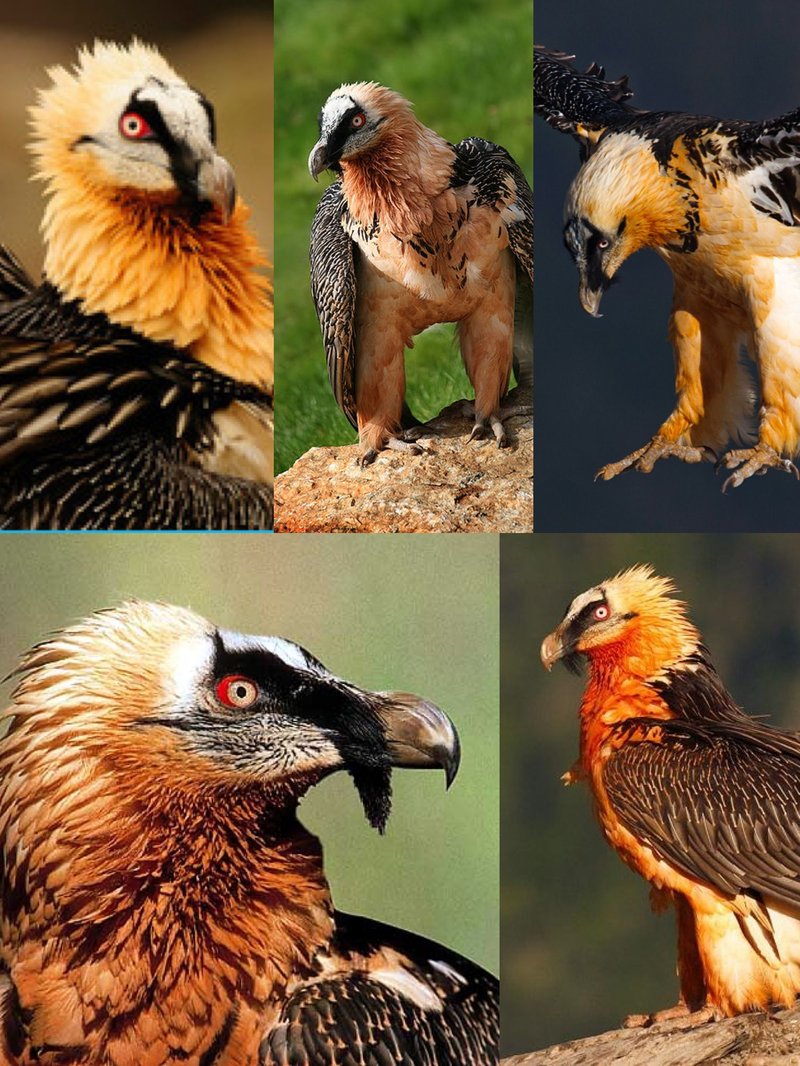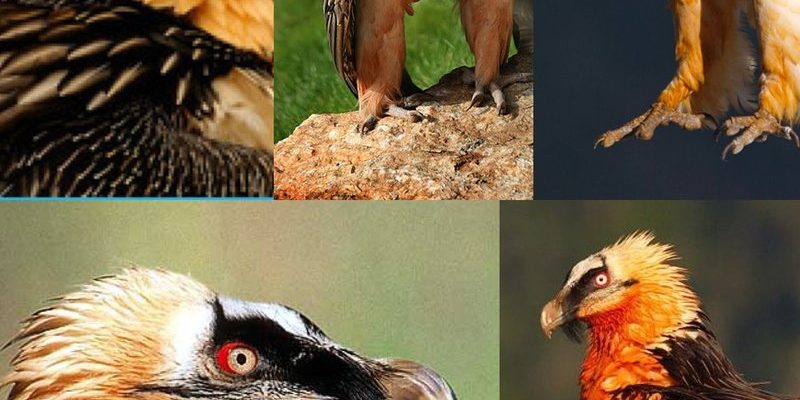
Imagine we’re sitting in a cozy café, sipping coffee, and chatting about the wildlife that captivates our imagination. You’d probably want to know about these fascinating creatures that, like the Bearded Vulture, showcase nature’s wonders—each with its distinct traits. Let’s dive into the world of these ten animals similar to the Bearded Vulture and discover what sets them apart.
1. Griffon Vulture
The **Griffon Vulture** is a close relative of the Bearded Vulture. Both belong to the *Accipitridae* family, which includes other birds of prey. With its huge wingspan that can reach up to 9 feet, the Griffon Vulture is a sight to behold as it glides gracefully through the sky.
These vultures primarily feed on carrion, just like their Bearded cousins. However, one of the main differences lies in their plumage. The Griffon Vulture has a light brown body with a distinctive yellowish neck, while the Bearded Vulture features a striking rufous and black coloration. When seen in the wild, the Griffon Vulture’s silhouette can often be mistaken for that of the Bearded Vulture, especially if you’re enjoying a hike in the mountains.
But here’s the thing: while both are scavengers, the Griffon Vulture has a more traditional diet, focusing on meat scraps, whereas the Bearded Vulture prefers to feed on bones, dropping them from heights to crack them open. This diet truly sets them apart!
2. Egyptian Vulture
Next up is the **Egyptian Vulture**, another scavenger with striking features. Slightly smaller than both the Griffon and Bearded Vultures, the Egyptian Vulture sports a distinctive yellow face and white body with black wing tips. You could say it has a bit of an eccentric flair!
Unlike the Bearded Vulture, the Egyptian Vulture has a more varied diet, including fruit. Isn’t it fascinating that it sometimes uses tools to break open eggs? This behavior is relatively rare among birds and shows how intelligent these creatures can be. When they’re flying, you might confuse an Egyptian Vulture for a juvenile Bearded Vulture, but their smaller size and different color patterns give them away.
They often share habitats, so spotting them together isn’t uncommon. Just remember, if you’re in the right place at the right time, the Egyptian Vulture is more likely to be seen scavenging in open fields, while the Bearded Vulture is more of a mountain-dweller.
3. Andean Condor
Moving on to the **Andean Condor**, another impressive bird that shares some similarities with the Bearded Vulture. This giant bird is native to South America and is one of the largest flying birds in the world. Its large wingspan and black feathers make it an awe-inspiring sight as it soars high above the Andes mountains.
While both the Andean Condor and the Bearded Vulture display exceptional flight skills, they differ significantly in their feeding habits. The Andean Condor primarily feeds on carrion, much like the other vultures, but it tends to prefer larger carcasses. When you see one up close, you’ll notice its bald head, which helps it stay clean while feeding.
Now, if you’re trying to identify them, look for the Bearded Vulture’s unique “beard” of black feathers around its neck, which the Andean Condor lacks. In terms of personality, the Andean Condor is more social, often seen in flocks, while the Bearded Vulture is more solitary.
4. Lammergeier
Interestingly, the **Lammergeier** is another name for the Bearded Vulture. But it’s worth mentioning because it showcases how names can vary based on geographical regions. In parts of Europe and Asia, people refer to the Bearded Vulture as the Lammergeier, which means “lamb vulture” in German.
This name alludes to their unique feeding habits—where they will occasionally take young sheep or lambs. However, don’t let the name fool you; their primary diet still consists of bones! Understanding the difference in naming can be helpful if you’re reading about them in different sources.
Overall, when you hear Lammergeier, just remember, you’re still talking about the Bearded Vulture!
5. Red Kite
The **Red Kite** is another bird of prey that’s often confused with the Bearded Vulture due to its impressive flying abilities and similar habitat preferences. With its striking reddish-brown body and forked tail, the Red Kite is easy to spot when it’s soaring through the sky, looking for food.
Unlike the Bearded Vulture, this bird has a more varied diet, including small mammals and carrion. It’s known for its graceful flight, making it one of the most beautiful birds to watch in the wild. When you look at their wings, you’ll notice that the Red Kite has long, pointed wings, while the Bearded Vulture has broader wings suited for soaring.
You might come across these birds in open fields or near forests. If you see a raptor with a pronounced forked tail, you’re likely looking at a Red Kite rather than a Bearded Vulture.
6. Eurasian Griffon
The **Eurasian Griffon** is yet another impressive vulture to consider. It shares a close evolutionary relationship with the Bearded Vulture and feeds on similar food sources. With a wingspan that can impressively stretch to about 8 feet, it’s a powerful flier.
The Eurasian Griffon can be distinguished by its brown plumage and distinctive neck ruff. While it feeds on carrion, it’s less specialized than the Bearded Vulture—eating just about anything that comes its way. When you spot it soaring with its long, broad wings, keep in mind that its silhouette will differ from that of the Bearded Vulture, which has a more compact appearance.
So, if you’re out birdwatching and you catch sight of a large vulture with a fluffy neck and brownish color, chances are you’re looking at a Eurasian Griffon rather than a Bearded Vulture.
7. California Condor
The **California Condor**, like the Andean Condor, is one of the largest flying birds. Native to North America, it was once on the brink of extinction but has made a comeback thanks to conservation efforts. These birds have a wingspan of about 10 feet, making them truly impressive in flight.
What sets the California Condor apart from the Bearded Vulture is their unique social structure and breeding habits. California Condors often live in groups and are known for their complex mating rituals. While they also feed on carrion, their diets can be more diverse, including smaller game.
If you’re trying to tell them apart, look for the California Condor’s distinct white wing patches contrasted against its dark feathers, something that the Bearded Vulture doesn’t have. Plus, their behavior is different; while Bearded Vultures are more solitary, California Condors thrive in social settings.
8. Turkey Vulture
Finally, we have the **Turkey Vulture**, a common sight in many areas. Unlike the Bearded Vulture, which enjoys the heights of mountainous terrains, Turkey Vultures are often seen flying low over fields and roads, searching for food. They have dark plumage and a distinctive red head, which can make them appear quite different from the Bearded Vulture’s unique features.
Turkey Vultures rely on their keen sense of smell to locate carrion, while Bearded Vultures primarily see it from high above. When you see a large bird with a wobbly flight, it’s probably a Turkey Vulture. Although their diets overlap, the Turkey Vulture is far less specialized than the Bearded Vulture.
The next time you’re out in nature, keep an eye out for these amazing birds and see if you can spot the differences.
In summary, while the **Bearded Vulture** stands out for its incredible personality and unique bone-eating habits, it shares the skies and ecosystems with many fascinating birds and mammals. Each of the animals we discussed today—like the Griffon Vulture, Andean Condor, and Turkey Vulture—bring their unique flair to the avian world.
So whether you’re an avid birdwatcher or just someone curious about nature, knowing these similarities and differences can enhance your appreciation for wildlife. Next time you’re hiking or exploring, take a moment to look up and recognize these magnificent creatures that share our planet. It’s a wild world out there, and every bird has its story to tell!

